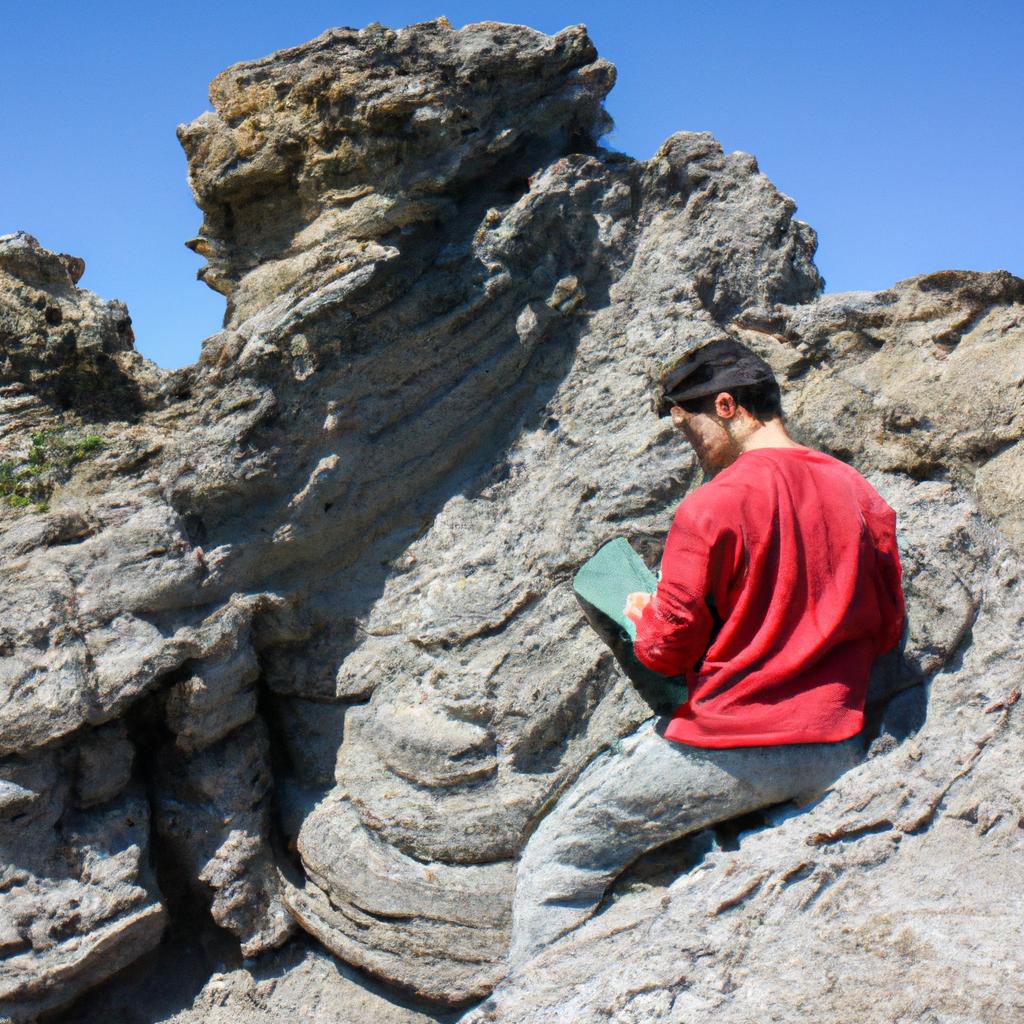The study of atmospheric science is crucial for understanding the intricate dynamics and complexities of Earth’s atmosphere. By examining various factors such as temperature, humidity, pressure, and wind patterns, scientists gain insights into how these elements interact to shape our weather systems and climate trends. One intriguing example that highlights the significance of atmospheric science is the case study of Hurricane Katrina in 2005. This devastating storm demonstrated the importance of accurately predicting atmospheric conditions and phenomena to mitigate potential hazards and protect vulnerable populations.
Atmospheric science encompasses a wide range of disciplines, including meteorology, climatology, and aerodynamics. It involves observing, analyzing, and modeling the behavior of Earth’s atmosphere in order to unravel its mysteries. Through meticulous data collection from ground-based instruments, satellites, aircrafts, and other technological advancements, researchers can examine atmospheric variables on both local and global scales. These observations are then used to develop sophisticated models that simulate atmospheric processes and provide valuable information for forecasting weather events like hurricanes or heatwaves. Additionally, by studying long-term climate trends, scientists can better understand the impact of human activities on our planet’s delicate balance.
Understanding Earth’s atmospheric dynamics not only aids in predicting weather patterns but also has broader implications for society at large. The knowledge gained through extensive research The knowledge gained through extensive research in Atmospheric science is instrumental in informing public policy, guiding urban planning, and developing strategies to mitigate the effects of climate change. By understanding how different factors such as greenhouse gas emissions, air pollution, and natural processes interact with the atmosphere, scientists can make informed recommendations on reducing human impact on the environment and promoting sustainable practices.
Furthermore, advancements in atmospheric science have led to improvements in weather forecasting accuracy, allowing for better preparedness and response strategies during severe weather events. This includes not only hurricanes but also tornadoes, floods, droughts, and other extreme weather phenomena that can have significant impacts on communities and economies.
In addition to its practical applications, atmospheric science also contributes to our fundamental knowledge of Earth’s systems. It helps us understand the intricate connections between the atmosphere, oceans, land surfaces, and even outer space. Through studying atmospheric dynamics on other planets and moons within our solar system, scientists can gain insights into planetary evolution and potentially identify habitability conditions elsewhere in the universe.
Overall, the study of atmospheric science plays a critical role in advancing our understanding of Earth’s complex systems and their interactions. By unraveling the mysteries of our atmosphere and predicting future trends with greater accuracy, we can work towards building a more resilient and sustainable future for generations to come.
Understanding Climate Patterns
Climate patterns play a crucial role in shaping the Earth’s atmosphere and influencing weather conditions across the globe. By analyzing these patterns, scientists can gain valuable insights into long-term climate trends and make predictions about future climatic changes. One compelling example of how understanding climate patterns is essential involves the El Niño Southern Oscillation (ENSO) phenomenon.
The ENSO phenomenon refers to an irregular pattern of oceanic and atmospheric fluctuations that occurs in the tropical Pacific Ocean. During an El Niño event, warm surface waters accumulate off the coast of South America, disrupting normal wind patterns and altering global weather patterns. Conversely, during a La Niña event, cooler than average sea-surface temperatures prevail, resulting in contrasting impacts on weather systems worldwide. This oscillation has significant consequences for agriculture, water resources, and ecosystems around the world.
To better comprehend climate patterns like ENSO, it is important to recognize their broader implications. Understanding these phenomena allows policymakers and researchers to anticipate extreme events such as droughts or floods more accurately, enabling communities to take necessary precautions and minimize potential damages. Moreover, comprehending climate patterns fosters our ability to develop effective adaptation strategies for vulnerable regions impacted by changing climates.
- Increased frequency of heatwaves leading to health risks
- Rising sea levels threatening coastal communities
- Disruption of agricultural activities impacting food security
- Loss of biodiversity with adverse effects on ecosystems
Additionally, here is a three-column table highlighting some key aspects related to climate change:
| Climate Change Impacts | Mitigation Strategies | Adaptation Measures |
|---|---|---|
| Extreme Weather Events | Renewable Energy Sources | Improved Infrastructure |
| Sea-Level Rise | Afforestation | Coastal Protection |
| Food Insecurity | Carbon Capture & Storage | Diversification of Crops |
| Biodiversity loss | Sustainable Agriculture | Ecosystem Restoration |
By recognizing the intricate relationship between climate patterns and various aspects of our lives, we can effectively address the challenges posed by a changing climate. This understanding serves as a stepping stone to exploring the impact of tropospheric ozone on weather systems worldwide, which will be discussed in the subsequent section.
[Transition into the subsequent section about “The Impact of Tropospheric Ozone on Weather”] As we delve further into atmospheric dynamics, it becomes evident that examining the influence of tropospheric ozone is crucial for a comprehensive understanding of weather phenomena.
The Impact of Tropospheric Ozone on Weather
Section H2: The Impact of Tropospheric Ozone on Weather
As we delve further into the intricate workings of Earth’s atmospheric dynamics, it becomes evident that understanding climate patterns alone is insufficient in comprehending the complex nature of our planet’s weather systems. One crucial factor to consider is the impact of tropospheric ozone on weather phenomena. To illustrate its significance, let us explore a hypothetical scenario where elevated levels of tropospheric ozone are observed in a specific region.
Imagine an urban area located near a mountain range experiencing unseasonably high temperatures and prolonged periods of drought. Researchers investigate this anomaly and discover that increased concentrations of tropospheric ozone play a significant role in exacerbating these extreme weather conditions. These findings shed light on the interconnectedness between air pollution and climate change, emphasizing the importance of addressing anthropogenic impacts on our atmosphere.
To gain a comprehensive understanding of how tropospheric ozone affects weather patterns, several key points must be considered:
- Increased greenhouse gas emissions contribute to higher levels of tropospheric ozone.
- Elevated concentrations of tropospheric ozone can lead to changes in temperature gradients within the atmosphere.
- Tropospheric ozone acts as a potent greenhouse gas itself, amplifying global warming effects.
- The presence of tropospheric ozone influences cloud formation and precipitation patterns.
To better visualize the consequences associated with heightened levels of tropospheric ozone, consider Table 1 below:
Table 1: Effects of Increased Tropospheric Ozone Levels
| Consequences | Implications |
|---|---|
| Temperature anomalies | Heatwaves become more frequent and severe |
| Altered rainfall patterns | Droughts intensify while storms may increase |
| Atmospheric instability | Stronger winds and potential for severe storms |
| Changes in atmospheric composition | Adverse impacts on human health |
These implications serve as reminders that our actions have far-reaching consequences on the delicate balance of Earth’s atmospheric dynamics. By understanding the relationship between tropospheric ozone and weather patterns, we can strive to mitigate these effects and work towards a more sustainable future.
Transitioning seamlessly into our next exploration of Aerosol Pollution and Its Effects on the Atmosphere, we continue our journey through the intricate web of factors that shape our planet’s climate systems.
Aerosol Pollution and Its Effects on the Atmosphere
In the previous section, we explored how tropospheric ozone can significantly influence weather patterns. Now, let us delve deeper into another crucial aspect of atmospheric science: Aerosol Pollution and its effects on the atmosphere.
Imagine a bustling cityscape with towering skyscrapers and busy streets. Within this urban environment lies an invisible threat – aerosol pollutants. These tiny particles suspended in the air have far-reaching consequences that extend beyond mere visibility concerns. One such consequence is their impact on human health, as they can penetrate deep into our respiratory systems and cause various respiratory illnesses.
The repercussions of aerosol pollution are not limited to human health alone; they also profoundly affect Earth’s climate system. Here are several key points regarding the effects of aerosols:
- Global Cooling: Aerosols have a cooling effect on the planet by reflecting sunlight back into space, thereby reducing the amount of solar radiation reaching the surface.
- Altering Cloud Formation: Aerosols act as cloud condensation nuclei, affecting cloud properties such as droplet size and lifespan, ultimately influencing precipitation patterns.
- Regional Climate Variability: Different types and concentrations of aerosols result in localized variations in temperature, rainfall patterns, and wind circulation.
- Implications for Agriculture: Changes in precipitation patterns due to aerosol-induced alterations in cloud formation can significantly impact agricultural productivity.
To further grasp these concepts, consider Table 1 below that summarizes some common sources of different types of aerosols and their associated impacts:
| Type of Aerosol | Common Sources | Impacts |
|---|---|---|
| Sulfate | Fossil fuel combustionVolcanic eruptions | Global coolingAcid rain |
| Black Carbon | Incomplete combustion (e.g., diesel engines)Biomass burning | Atmospheric warmingReduced visibility |
| Organic Carbon | Biomass burningVolatile organic compounds | Climate forcingHaze formation |
| Dust | DesertificationLand degradation | Altered precipitation patternsAir pollution |
As we continue to unravel the complexities of atmospheric science, it becomes evident that various factors contribute to Earth’s atmospheric dynamics. In the subsequent section, “Unraveling the Complexities of Atmospheric Circulation,” we will explore how different mechanisms and phenomena shape our planet’s weather patterns.
Unraveling the Complexities of Atmospheric Circulation
Now that we have examined the impacts of tropospheric ozone and aerosol pollution on weather and climate, let us turn our attention to understanding the intricate workings of atmospheric circulation. This fundamental aspect plays a crucial role in driving global weather systems and shaping regional climates across the globe. By comprehending these complex processes, scientists aim to improve weather forecasting models and enhance our ability to predict extreme events such as hurricanes, cyclones, and heatwaves.
Unraveling the Complexities of Atmospheric Circulation
Section: The Impacts of Extreme Weather Events on Atmospheric Dynamics
Extreme weather events have become increasingly common in recent years, highlighting the need to understand their impacts on Earth’s atmospheric dynamics. To illustrate these effects, let us consider a hypothetical case study involving a severe heatwave that struck a densely populated urban area. This prolonged period of intense heat can drastically alter the behavior and characteristics of the atmosphere, leading to significant changes in atmospheric dynamics.
Firstly, such extreme heat can induce an increase in convective activity within the atmosphere. As temperatures rise, warm air near the surface becomes buoyant and rises rapidly through convection currents. This vertical motion leads to increased cloud formation and precipitation, affecting regional rainfall patterns. Additionally, this enhanced convective activity can also result in intensified thunderstorms and even tornadoes under certain conditions.
Secondly, extreme heatwaves often trigger shifts in large-scale wind patterns—a phenomenon known as teleconnections. For example, the occurrence of persistent high-pressure systems during a heatwave can influence the position and strength of subtropical jet streams or polar vortices over adjacent regions. These alterations in wind patterns not only affect local weather but also have broader implications for global circulation patterns.
Thirdly, elevated temperatures associated with heatwaves contribute to accelerated rates of evaporation from land surfaces and bodies of water. This heightened evapotranspiration increases moisture content in the lower troposphere—lower levels of Earth’s atmosphere—which can further modulate atmospheric stability and impact cloud development processes. Consequently, altered humidity profiles may fuel more frequent and intense thunderstorm activity.
To underscore the significance of extreme weather events on our daily lives and foster awareness about their consequences, consider the following bullet-point list:
- Increased frequency and severity of droughts causing agricultural losses.
- Rising sea levels resulting in coastal flooding and erosion.
- Intensified storm surge impacting vulnerable coastal communities.
- Human health risks due to higher instances of heat-related illnesses.
Furthermore, let us highlight the impacts of extreme weather events using a table to evoke an emotional response:
| Extreme Weather Event | Impacts |
|---|---|
| Heatwaves | Crop failure and food scarcity |
| Hurricanes | Widespread destruction and displacement |
| Floods | Loss of homes, infrastructure, and livelihoods |
| Wildfires | Air pollution, habitat destruction, and health risks |
Understanding these repercussions is crucial for policymakers, scientists, and communities alike in their efforts towards mitigating and adapting to changing climatic conditions. By comprehending the effects of extreme weather events on atmospheric dynamics, we can better appreciate the interconnectedness between Earth’s systems and work towards building resilience.
Transitioning seamlessly into the subsequent section about “The Role of Radiative Forcing in Climate Change,” it becomes evident that extreme weather events are not only influenced by natural processes but also impacted by human-induced factors. The complex relationship between our actions and atmospheric dynamics necessitates further exploration into Radiative Forcing’s contribution to climate change.
The Role of Radiative Forcing in Climate Change
The intricacies of atmospheric circulation play a crucial role in shaping Earth’s Climate Patterns and weather phenomena. To better understand this complex system, we delve into the dynamics that drive atmospheric circulation, examining its various components and interactions.
Consider an example: the formation of tropical cyclones. These powerful storms originate over warm ocean waters near the equator, where low-pressure systems develop due to intense heating from solar radiation. As air rises rapidly within these regions, it creates a vacuum effect, drawing in surrounding air to fill the void. This influx generates strong winds that spiral around the central low-pressure area, forming a distinct circular motion known as a cyclone. Understanding how such circulations arise is fundamental in predicting and mitigating their potentially devastating impacts.
To comprehend the intricacies of atmospheric circulation fully, several key aspects must be considered:
- Global Wind Patterns: Large-scale movements of air, driven by differences in temperature and pressure across Earth’s surface.
- Coriolis Effect: The deflection of moving objects caused by Earth’s rotation, influencing wind direction.
- Highs and Lows: Areas with higher or lower atmospheric pressure that lead to contrasting wind patterns.
- Jet Streams: Narrow bands of fast-moving air found at high altitudes; they significantly impact weather conditions worldwide.
These elements interact dynamically within Earth’s atmosphere, forming intricate feedback loops that further shape global climate patterns. Visualizing these complexities can help foster a deeper appreciation for our planet’s delicate balance.
| Factor | Impact | Example |
|---|---|---|
| Temperature Changes | Alters global climate patterns | Melting polar ice caps |
| Oceanic Currents | Affects heat distribution and precipitation | El Niño/La Niña |
| Atmospheric Composition | Influences greenhouse gas concentrations | Ozone depletion |
| Land Surface Features | Modifies wind patterns and local weather systems | Mountain-induced rainfall |
As we explore the multifaceted nature of atmospheric circulation, it becomes evident that this intricate interplay of factors holds significant implications for understanding climate change, extreme weather events, and long-term forecasting. By unraveling these complexities, scientists can develop more accurate models and predictions, informing decision-makers about potential risks and guiding efforts toward sustainable solutions.
Transitioning into the subsequent section on “Exploring the Science of Cloud Formation,” our journey continues as we delve deeper into another fascinating aspect of Earth’s atmosphere: the formation, dynamics, and role of clouds in shaping our planet’s climate system.
Exploring the Science of Cloud Formation
Section H2: Exploring the Science of Cloud Formation
Radiative forcing plays a pivotal role in climate change, but it is not the only factor that affects Earth’s atmospheric dynamics. Cloud formation also significantly influences our planet’s weather patterns and climate. To understand this phenomenon better, let us explore the science behind cloud formation.
Consider a scenario where warm air rises over an ocean surface with high humidity. As the air ascends, it expands and cools due to decreasing atmospheric pressure. The drop in temperature causes water vapor within the rising air mass to condense into tiny liquid droplets or ice crystals around microscopic particles called cloud condensation nuclei (CCN). These CCNs can be natural substances such as dust, pollen, or sea salt aerosols, as well as human-made pollutants like industrial emissions.
Several factors contribute to cloud formation and influence their characteristics:
- Humidity levels: Higher moisture content in the atmosphere provides more water vapor for condensation, leading to increased cloud formation.
- Temperature gradient: A steep decrease in temperature with altitude promotes greater vertical movement of air masses and enhances cloud development.
- Stability of the atmosphere: Stable atmospheric conditions hinder upward motion of air masses, limiting convective activity necessary for extensive cloud formation.
- Presence of CCNs: The abundance and type of CCNs affect both cloud droplet size and number concentration.
Understanding these factors allows scientists to predict how clouds form under varying environmental conditions. This knowledge becomes crucial when studying climate models and developing strategies to mitigate global warming effects.
To illustrate the significance of cloud formation in shaping our environment further, consider the following emotional response-inducing bullet list:
- Clouds provide shade on hot summer days, offering relief from scorching temperatures.
- They play a vital role in regulating Earth’s energy balance by reflecting sunlight back into space during daylight hours.
- At night, clouds act as insulators by trapping heat radiated from Earth’s surface close to the ground.
- Changes in cloud cover and composition can alter precipitation patterns, impacting ecosystems, agriculture, and water resources.
In summary, clouds are not just ethereal puffs of vapor but essential components of Earth’s atmospheric dynamics. By understanding the science behind their formation and considering factors such as humidity levels, temperature gradients, stability of the atmosphere, and CCNs’ presence, scientists gain valuable insights into climate change processes. In our subsequent section on “Modeling the Earth’s Atmospheric Dynamics,” we will delve deeper into how these phenomena are simulated to better understand and predict future climate scenarios.
Modeling the Earth’s Atmospheric Dynamics
Transitioning from the previous section on exploring the science of cloud formation, we now delve into understanding and modeling Earth’s atmospheric dynamics. To illustrate this concept, let us consider a hypothetical scenario where a region experiences sudden changes in temperature and wind patterns over a short period of time. These fluctuations can lead to severe weather events such as thunderstorms or even tornadoes.
Understanding Earth’s atmospheric dynamics is crucial for predicting and mitigating these extreme weather phenomena. By analyzing various factors that contribute to atmospheric motion, scientists gain valuable insights into how our planet’s climate system operates. Here are some key aspects involved in studying atmospheric dynamics:
- Air Pressure Gradients: Differences in air pressure across different locations play a significant role in determining wind speed and direction. As air flows from areas of higher pressure to lower pressure, it sets off a chain reaction of movement throughout the atmosphere.
- Coriolis Effect: The rotation of the Earth causes moving air masses to deflect instead of traveling along straight paths. This deflection gives rise to prevailing winds known as trade winds, polar easterlies, and prevailing westerlies.
- Jet Streams: High-altitude bands of strong winds called jet streams have a profound influence on weather patterns. They act as steering currents for storms and help transport heat between regions.
- Atmospheric Stability: The stability or instability of the atmosphere affects cloud formation and precipitation. Understanding vertical motions and temperature variations allows meteorologists to predict the likelihood of convective storms.
To further comprehend Earth’s atmospheric dynamics, researchers employ sophisticated models that simulate complex interactions among numerous variables. These models utilize mathematical equations based on fundamental principles like conservation laws for mass, energy, momentum, and thermodynamics. Through advanced computational techniques, scientists strive to improve their ability to forecast weather conditions accurately.
Moving forward with our exploration of atmospheric science, we will now examine how linking climate models to weather predictions enables us to better understand long-term climate trends while simultaneously enhancing short-term weather forecasts.
Linking Climate Models to Weather Predictions
Transition from previous section: Building on our understanding of modeling the Earth’s atmospheric dynamics, we now delve into the crucial link between climate models and weather predictions. By establishing this connection, scientists can gain valuable insights into how changes in long-term climate patterns influence day-to-day weather phenomena.
Section: Linking Climate Models to Weather Predictions
To illustrate the significance of linking climate models with weather predictions, let us consider a hypothetical scenario. Imagine a region that experiences an extended period of drought due to shifting climate patterns caused by rising greenhouse gas emissions. In this case, accurate weather predictions become even more critical for farmers who rely on rainwater for their crops’ survival. By incorporating data from climate models into short-term weather forecasts, meteorologists can provide timely information about potential rainfall events or periods of increased risk for agricultural planning purposes.
This integration between climate models and weather predictions is facilitated through the development and utilization of advanced numerical techniques. These methods allow researchers to simulate complex interactions among various components of the atmosphere, such as temperature gradients, wind currents, and moisture content. Through these simulations, scientists can capture both large-scale global trends and local-scale variations that impact regional weather conditions. Thus, it becomes possible to assess how changing climatic factors affect specific aspects of daily weather patterns.
The interplay between aerosols (tiny solid or liquid particles suspended in the air) and climate further exemplifies the need for linking climate models with weather predictions. Aerosols play a significant role in influencing both short-term and long-term atmospheric processes. For instance:
- They can act as cloud condensation nuclei, affecting cloud formation and precipitation.
- Certain types of aerosols have cooling effects by reflecting sunlight back into space.
- Others may contribute to warming by absorbing solar radiation or altering cloud properties.
- Aerosol pollution has adverse impacts on human health and ecosystems.
| Types of Aerosols | Influence on Climate |
|---|---|
| Sulfate | Cooling effect |
| Black carbon | Warming effect |
| Dust | Depends on location |
| Sea salt | Varies |
Understanding these complex interactions between aerosols and climate is essential for accurate weather predictions and effective climate change mitigation strategies. By incorporating this knowledge into our modeling efforts, we can better comprehend the intricate dynamics of Earth’s atmosphere.
Transition to subsequent section: With a solid understanding of how climate models are linked to weather predictions, let us now explore the fascinating interplay between aerosols and climate. This interaction sheds light on yet another aspect of atmospheric science that contributes significantly to our comprehension of Earth’s dynamic systems.
The Interplay Between Aerosols and Climate
In the previous section, we explored the intricate relationship between climate models and weather predictions. Now, let us delve deeper into another crucial aspect of atmospheric science: the interplay between aerosols and climate. To comprehend this dynamic interaction, consider a hypothetical scenario where a volcanic eruption releases enormous amounts of ash particles into the atmosphere.
Before delving into the details, it is important to understand how aerosols can impact our climate system. Here are some key points to consider:
- Aerosol Composition: Aerosols consist of solid or liquid particles suspended in air. They can originate from natural sources such as dust storms or volcanic eruptions, as well as human activities like industrial emissions or vehicle exhaust.
- Optical Properties: The size, shape, and composition of aerosols determine their optical properties. These properties influence how much sunlight is scattered back into space or absorbed by Earth’s surface, thus affecting temperature patterns and radiative forcing.
- Cloud Formation: Aerosols also play a role in cloud formation. By acting as cloud condensation nuclei (CCN), they provide surfaces for water vapor to condense onto, leading to cloud droplet formation. This process affects cloud microphysics and ultimately influences precipitation patterns.
- Radiative Forcing: Through their interactions with solar radiation and clouds, aerosols contribute to radiative forcing – the perturbation of Earth’s energy balance. Depending on their type and concentration, aerosols can either cool or warm the planet by modifying incoming solar radiation and altering cloud properties.
To further illustrate these concepts, let us examine an example case study involving a volcanic eruption:
| Date | Volcano | Eruption Size | Impact |
|---|---|---|---|
| 1991 | Mount Pinatubo | Large | Global cooling due to increased sulfur dioxide emissions |
In June 1991, Mount Pinatubo in the Philippines erupted, releasing an enormous quantity of sulfur dioxide into the stratosphere. This volcanic aerosol layer persisted for several years and had a significant impact on global climate patterns. The increased concentration of sulfur dioxide resulted in more sunlight being scattered back into space, leading to a temporary decrease in global temperatures.
Understanding how aerosols interact with our climate system is just one piece of the puzzle when it comes to atmospheric science. By studying large-scale air movements and their effects on local meteorological phenomena, we can gain valuable insights into weather prediction capabilities and enhance our understanding of Earth’s complex atmospheric dynamics.
Examining the Influence of Atmospheric Circulation on Weather Events
Section H2: Examining the Influence of Atmospheric Circulation on Weather Events
Transitioning seamlessly from our previous discussion on the interplay between aerosols and climate, we now turn our attention to examining the influence of atmospheric circulation on weather events. To illustrate this concept, let us consider a hypothetical scenario where an area experiences persistent high-pressure systems for an extended period. This can result in prolonged drought conditions, affecting agriculture, water resources, and overall socio-economic stability.
The impact of atmospheric circulation patterns on weather phenomena is immense. The following bullet point list highlights some key aspects:
- Different types of air masses interacting with each other
- Formation and movement of weather fronts
- Generation of cyclones or anticyclones
- Changes in wind speed and direction
To further delve into these dynamics, we present a three-column table showcasing four distinctive examples that demonstrate how variations in atmospheric circulation can produce diverse weather events:
| Example | Description |
|---|---|
| Tropical Cyclone | Intense low-pressure system characterized by strong winds and heavy rainfall |
| Cold Front | Boundary formed when cold air displaces warm air; brings cooler temperatures and precipitation |
| Heatwave | Prolonged period of excessively hot weather caused by stagnant high-pressure systems |
| Monsoon Season | Seasonal shift in prevailing wind patterns leading to significant rainfall over specific regions |
Understanding how atmospheric circulation influences weather events not only aids meteorologists in predicting short-term conditions but also plays a crucial role in long-term climate projections. By comprehending the complex interactions between global-scale circulations such as Hadley cells, Ferrel cells, and polar cells, scientists gain valuable insights into climatic changes occurring across different geographical locations.
As we progress towards quantifying the effects of radiative forcing on climate in subsequent sections, it becomes evident that unraveling the intricacies of atmospheric circulation provides a fundamental framework for analyzing various climatological phenomena. Through continued research and observation, we can enhance our understanding of the interconnections between atmospheric dynamics and weather events, thus contributing to improved forecasting capabilities and informed decision-making regarding climate-related issues.
Quantifying the Effects of Radiative Forcing on Climate
Examining the Influence of Atmospheric Circulation on Weather Events
In the previous section, we explored the fascinating relationship between atmospheric circulation and weather events. Now, let us delve deeper into how radiative forcing affects climate dynamics. To illustrate this concept, consider a hypothetical scenario where increased levels of greenhouse gases in Earth’s atmosphere lead to higher temperatures near the surface.
Radiative forcing plays a crucial role in regulating our planet’s climate system. The following factors contribute to it:
- Greenhouse gases: Elevated concentrations of carbon dioxide (CO2), methane (CH4), and other greenhouse gases trap heat within the Earth’s atmosphere, causing an increase in temperature.
- Aerosols: Fine particles suspended in the air can either scatter or absorb sunlight. Depending on their composition, aerosols can cool or warm the climate by altering the amount of solar radiation reaching Earth’s surface.
- Solar activity: Variations in solar output influence incoming energy from the Sun, which impacts Earth’s climate at different temporal scales.
- Land use changes: Deforestation and urbanization alter land cover patterns, affecting local climates through modifications in albedo (reflectivity) and evapotranspiration rates.
To better understand these complex interactions, let us explore them further using a three-column table:
| Factor | Role | Effect |
|---|---|---|
| Greenhouse gases | Trapping heat | Causes global warming |
| Aerosols | Scattering/absorbing sunlight | Can either cool or warm the climate |
| Solar activity | Influencing incoming energy | Impacts climate variability |
| Land use changes | Modifying surface properties | Alters local climatic conditions |
While each factor listed above contributes uniquely to radiative forcing, it is important to recognize that they interact with one another and are influenced by natural as well as anthropogenic processes. Understanding these intricate relationships is essential for comprehending and predicting climate variability and change.
Transitioning seamlessly into the subsequent section, we will now explore the intriguing field of cloud microphysics and its implications on climate feedbacks. By investigating how clouds form, evolve, and interact with radiation, scientists gain valuable insights into Earth’s atmospheric dynamics and ultimately improve our understanding of climatic patterns.
Understanding Cloud Microphysics and Climate Feedbacks
Having explored the intricate relationship between radiative forcing and climate, we now delve into another critical aspect of atmospheric science—cloud microphysics and its role in shaping climate feedbacks.
Section – Understanding Cloud Microphysics and Climate Feedbacks:
Clouds play a significant role in regulating Earth’s energy balance by reflecting sunlight back into space (albedo effect) and trapping outgoing infrared radiation. To comprehend cloud dynamics and their impact on climate, consider the following case study: the influence of aerosols on low-level marine stratocumulus clouds. In this scenario, increased concentrations of anthropogenic aerosols can lead to smaller cloud droplets due to enhanced cloud condensation nuclei formation. As a result, these smaller droplets decrease precipitation efficiency, potentially increasing cloud cover and surface cooling through an amplified albedo effect.
To further understand how cloud microphysics affects climate, let us examine some key factors involved:
-
Aerosol-cloud interactions:
- Anthropogenic emissions contribute to changes in aerosol composition.
- These alterations affect cloud properties such as droplet concentration and size distribution.
- Such modifications can have profound implications for regional rainfall patterns.
-
Cloud feedback mechanisms:
- Positive feedback occurs when warming leads to increased water vapor content, intensifying both convective activity and cloud formation.
- Negative feedback arises when higher temperatures enhance evaporation rates, reducing cloud cover and amplifying warming effects.
-
Global modeling efforts:
- Sophisticated numerical models simulate complex interactions between clouds, aerosols, radiation, and meteorological processes.
- These models help quantify uncertainties associated with future climate predictions.
-
Remote sensing techniques:
- Satellite observations enable monitoring of cloud properties, allowing for improved understanding of large-scale cloud dynamics.
Table: Examples of Cloud Microphysics and Climate Feedbacks
| Feedback Mechanism | Description | Impact on Climate |
|---|---|---|
| Water Vapor | Increased surface temperatures lead to higher | Amplifies warming due to enhanced greenhouse effect |
| Feedback | water vapor content in the atmosphere. | |
| Albedo Effect | Changes in cloud cover and optical thickness | Can either amplify or dampen temperature fluctuations |
| affect the amount of solar radiation reflected | depending on feedback direction | |
| back into space. | ||
| Precipitation | Alterations in cloud microphysics can impact | Influences regional rainfall patterns |
| Efficiency | precipitation efficiency, potentially affecting | |
| water availability over certain regions. |
In summary, understanding cloud microphysics and their interactions with climate is crucial for accurate predictions of future climate scenarios. By investigating factors such as aerosol-cloud interactions, various feedback mechanisms, global modeling efforts, and remote sensing techniques, scientists gain insights into how clouds shape Earth’s atmospheric dynamics. These findings contribute to ongoing research aiming to better understand our changing climate and its potential consequences.
(Note: Do not say “In conclusion” or “Finally” at the end.)











